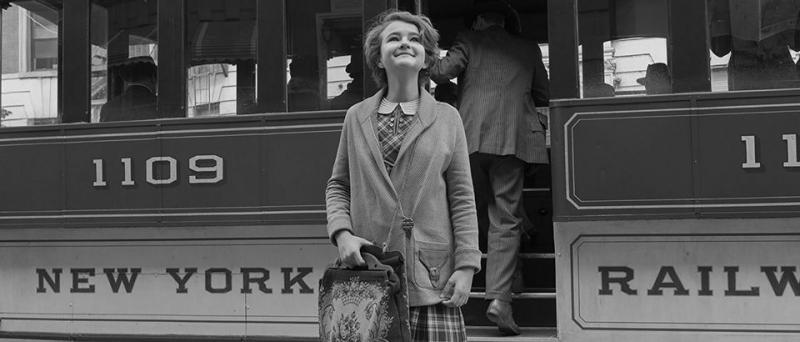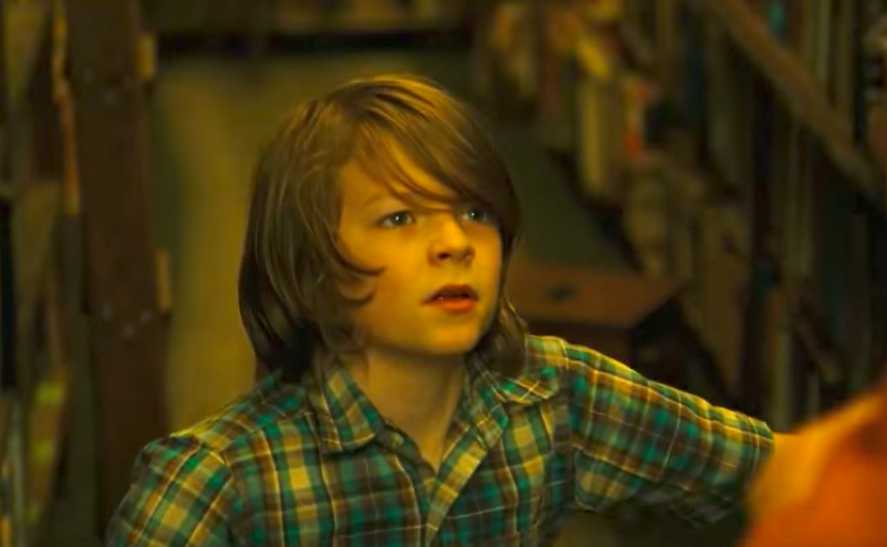Wonderstruck review - beautifully designed but emotionally unengaging | reviews, news & interviews
Wonderstruck review - beautifully designed but emotionally unengaging
Wonderstruck review - beautifully designed but emotionally unengaging
Todd Haynes's (double) period piece doesn't know if it's made for children or adults

What is it about Brian Selznick’s ornate illustrated fictions that leads good directors to make bad films? Turning The Invention of Hugo Cabret into Hugo was a near disaster for Scorsese, and now comes Todd Haynes’s stifling adaptation of Selznick’s novel, Wonderstruck.
Two different narratives intertwine, one set in the 1970s, the other in the 1920s. Both centre on children battling with hearing loss who embark on a solo quest in New York searching for an absent parent. Eventually their lives overlap, but it takes forever to get there. At one point the Julianne Moore character tells a child, "I need you to be patient with this story", but by then it’s way, way too late.
The three child actors are not hugely engaging, although Rose (played by deaf actress Millicent Simmonds, main picture) is at least very striking to look at and gives it her all. The two boys are cute moppets (Oakes Fegley, pictured below) but don’t have much to do but hide out for days in the American Museum of Natural History dodging adults in a wholly unbelievable way. It’s amazing that they didn’t stumble into the crew setting up for the Night at … series. As in his work on other period films like Carol, Haynes has put together an expert team of art directors and costumiers (including Britain's own wondrous Sandy Powell) and given them full rein to show their talents. The magnificent DP Ed Lachman does an expert job of capturing the grungy streets of Manhattan in the Seventies in Kodak colour. This homage to the mean streets of early Scorsese and the Harlem of the blaxploitation era is impressive. The lustrous black and white sequences set in the Twenties are perhaps a little weaker and a touch clichéd. There’s real artistry in Haynes' homage to DW Griffiths in the film-within-a-film, although Moore goes over the top as a melodrama star.
As in his work on other period films like Carol, Haynes has put together an expert team of art directors and costumiers (including Britain's own wondrous Sandy Powell) and given them full rein to show their talents. The magnificent DP Ed Lachman does an expert job of capturing the grungy streets of Manhattan in the Seventies in Kodak colour. This homage to the mean streets of early Scorsese and the Harlem of the blaxploitation era is impressive. The lustrous black and white sequences set in the Twenties are perhaps a little weaker and a touch clichéd. There’s real artistry in Haynes' homage to DW Griffiths in the film-within-a-film, although Moore goes over the top as a melodrama star.
But ultimately one comes away with the impression that far more thought has gone into creating impressive tableaux and evoking the patina of the past than working on a dynamic narrative or getting absorbing performances out of its young stars. Towards the end, Haynes breaks into charming stop-frame animation, but it’s not enough to save Wonderstruck; it’s simply too mannered for children and too slow for adults. For a far more modest but moving portrayal of life as a deaf child, the Oscar-winning British short, The Silent Child, is currently on iPlayer.
Overleaf: watch the trailer for Wonderstruck
What is it about Brian Selznick’s ornate illustrated fictions that leads good directors to make bad films? Turning The Invention of Hugo Cabret into Hugo was a near disaster for Scorsese, and now comes Todd Haynes’s stifling adaptation of Selznick’s novel, Wonderstruck.
Two different narratives intertwine, one set in the 1970s, the other in the 1920s. Both centre on children battling with hearing loss who embark on a solo quest in New York searching for an absent parent. Eventually their lives overlap, but it takes forever to get there. At one point the Julianne Moore character tells a child, "I need you to be patient with this story", but by then it’s way, way too late.
The three child actors are not hugely engaging, although Rose (played by deaf actress Millicent Simmonds, main picture) is at least very striking to look at and gives it her all. The two boys are cute moppets (Oakes Fegley, pictured below) but don’t have much to do but hide out for days in the American Museum of Natural History dodging adults in a wholly unbelievable way. It’s amazing that they didn’t stumble into the crew setting up for the Night at … series. As in his work on other period films like Carol, Haynes has put together an expert team of art directors and costumiers (including Britain's own wondrous Sandy Powell) and given them full rein to show their talents. The magnificent DP Ed Lachman does an expert job of capturing the grungy streets of Manhattan in the Seventies in Kodak colour. This homage to the mean streets of early Scorsese and the Harlem of the blaxploitation era is impressive. The lustrous black and white sequences set in the Twenties are perhaps a little weaker and a touch clichéd. There’s real artistry in Haynes' homage to DW Griffiths in the film-within-a-film, although Moore goes over the top as a melodrama star.
As in his work on other period films like Carol, Haynes has put together an expert team of art directors and costumiers (including Britain's own wondrous Sandy Powell) and given them full rein to show their talents. The magnificent DP Ed Lachman does an expert job of capturing the grungy streets of Manhattan in the Seventies in Kodak colour. This homage to the mean streets of early Scorsese and the Harlem of the blaxploitation era is impressive. The lustrous black and white sequences set in the Twenties are perhaps a little weaker and a touch clichéd. There’s real artistry in Haynes' homage to DW Griffiths in the film-within-a-film, although Moore goes over the top as a melodrama star.
But ultimately one comes away with the impression that far more thought has gone into creating impressive tableaux and evoking the patina of the past than working on a dynamic narrative or getting absorbing performances out of its young stars. Towards the end, Haynes breaks into charming stop-frame animation, but it’s not enough to save Wonderstruck; it’s simply too mannered for children and too slow for adults. For a far more modest but moving portrayal of life as a deaf child, the Oscar-winning British short, The Silent Child, is currently on iPlayer.
Overleaf: watch the trailer for Wonderstruck
The future of Arts Journalism
You can stop theartsdesk.com closing!
We urgently need financing to survive. Our fundraising drive has thus far raised £49,000 but we need to reach £100,000 or we will be forced to close. Please contribute here: https://gofund.me/c3f6033d
And if you can forward this information to anyone who might assist, we’d be grateful.

Subscribe to theartsdesk.com
Thank you for continuing to read our work on theartsdesk.com. For unlimited access to every article in its entirety, including our archive of more than 15,000 pieces, we're asking for £5 per month or £40 per year. We feel it's a very good deal, and hope you do too.
To take a subscription now simply click here.
And if you're looking for that extra gift for a friend or family member, why not treat them to a theartsdesk.com gift subscription?
more Film
 The Mastermind review - another slim but nourishing slice of Americana from Kelly Reichardt
Josh O'Connor is perfect casting as a cocky middle-class American adrift in the 1970s
The Mastermind review - another slim but nourishing slice of Americana from Kelly Reichardt
Josh O'Connor is perfect casting as a cocky middle-class American adrift in the 1970s
 Springsteen: Deliver Me From Nowhere review - the story of the Boss who isn't boss of his own head
A brooding trip on the Bruce Springsteen highway of hard knocks
Springsteen: Deliver Me From Nowhere review - the story of the Boss who isn't boss of his own head
A brooding trip on the Bruce Springsteen highway of hard knocks
 The Perfect Neighbor, Netflix review - Florida found-footage documentary is a harrowing watch
Sundance winner chronicles a death that should have been prevented
The Perfect Neighbor, Netflix review - Florida found-footage documentary is a harrowing watch
Sundance winner chronicles a death that should have been prevented
 Blu-ray: Le Quai des Brumes
Love twinkles in the gloom of Marcel Carné’s fogbound French poetic realist classic
Blu-ray: Le Quai des Brumes
Love twinkles in the gloom of Marcel Carné’s fogbound French poetic realist classic
 Frankenstein review - the Prometheus of the charnel house
Guillermo del Toro is fitfully inspired, but often lost in long-held ambitions
Frankenstein review - the Prometheus of the charnel house
Guillermo del Toro is fitfully inspired, but often lost in long-held ambitions
 London Film Festival 2025 - a Korean masterclass in black comedy and a Camus classic effectively realised
New films from Park Chan-wook, Gianfranco Rosi, François Ozon, Ildikó Enyedi and more
London Film Festival 2025 - a Korean masterclass in black comedy and a Camus classic effectively realised
New films from Park Chan-wook, Gianfranco Rosi, François Ozon, Ildikó Enyedi and more
 After the Hunt review - muddled #MeToo provocation
Julia Roberts excels despite misfiring drama
After the Hunt review - muddled #MeToo provocation
Julia Roberts excels despite misfiring drama
 Ballad of a Small Player review - Colin Farrell's all in as a gambler down on his luck
Conclave director Edward Berger swaps the Vatican for Asia's sin city
Ballad of a Small Player review - Colin Farrell's all in as a gambler down on his luck
Conclave director Edward Berger swaps the Vatican for Asia's sin city
 London Film Festival 2025 - Bradley Cooper channels John Bishop, the Boss goes to Nebraska, and a French pandemic
... not to mention Kristen Stewart's directing debut and a punchy prison drama
London Film Festival 2025 - Bradley Cooper channels John Bishop, the Boss goes to Nebraska, and a French pandemic
... not to mention Kristen Stewart's directing debut and a punchy prison drama
 London Film Festival 2025 - from paranoia in Brazil and Iran, to light relief in New York and Tuscany
'Jay Kelly' disappoints, 'It Was Just an Accident' doesn't
London Film Festival 2025 - from paranoia in Brazil and Iran, to light relief in New York and Tuscany
'Jay Kelly' disappoints, 'It Was Just an Accident' doesn't
 Iron Ladies review - working-class heroines of the Miners' Strike
Documentary salutes the staunch women who fought Thatcher's pit closures
Iron Ladies review - working-class heroines of the Miners' Strike
Documentary salutes the staunch women who fought Thatcher's pit closures
 Blu-ray: The Man in the White Suit
Ealing Studios' prescient black comedy, as sharp as ever
Blu-ray: The Man in the White Suit
Ealing Studios' prescient black comedy, as sharp as ever

Add comment